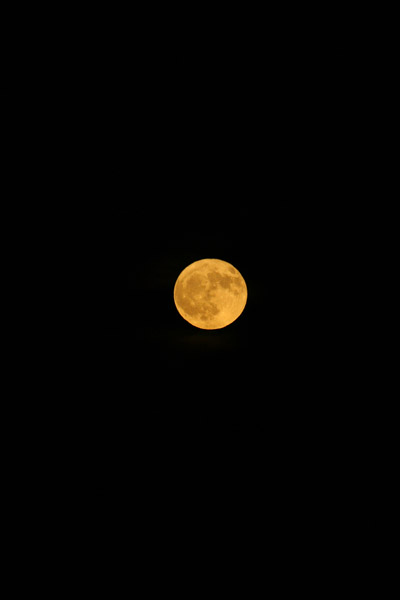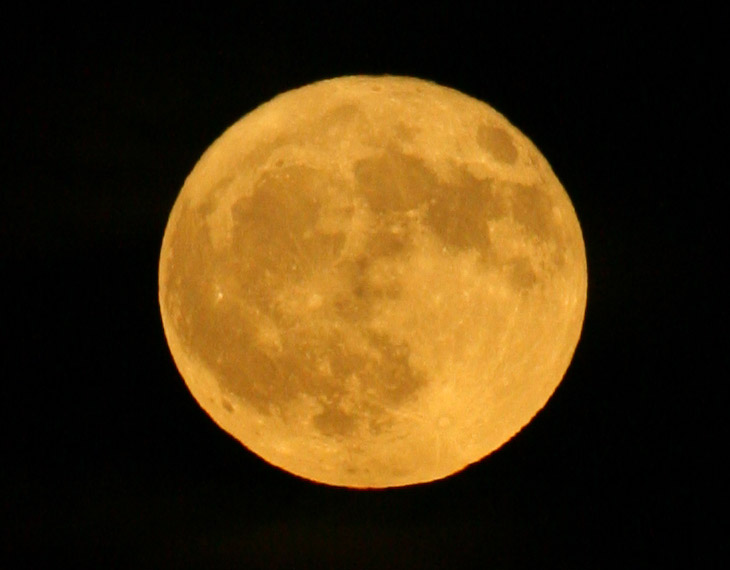
Today, October 6th, is International Time Warp Day, and to celebrate, I’m going to use the oft-ignored option in WordPress to publish this post at a random date, either ahead of or behind when I’m actually typing it. I couldn’t ever find a use for the function before, but I realized it was handy for this holiday.
Last night, the Insurmountable Mr. Bugg and I went out to Jordan Lake to try and capture the sunset, which, as I’ve said before, can be hit-or-miss – it’s really hard to predict just how the colors might turn out, even just an hour in advance. You might think that conditions like completely clear skies or complete overcast would let you predict that the sunset would be crappy, but I’ve seen things change in only minutes to produce some really great colors and skyscapes. Just, you know, not this time…
 The moon, however, was more cooperative. As you can see from the widget on the sidebar there [okay, maybe not] the moon was full last night, and rose with a lovely golden hue. For reasons unknown, I hadn’t brought the tripod along, so I was forced to shoot handheld, not the best of options for clarity in telephoto shots. The old Canon 100-300 L lens was in my corner though, and I got more detail than I really expected. To give you an idea, the image to the right is the full frame of the detail crop that’s coming below.
The moon, however, was more cooperative. As you can see from the widget on the sidebar there [okay, maybe not] the moon was full last night, and rose with a lovely golden hue. For reasons unknown, I hadn’t brought the tripod along, so I was forced to shoot handheld, not the best of options for clarity in telephoto shots. The old Canon 100-300 L lens was in my corner though, and I got more detail than I really expected. To give you an idea, the image to the right is the full frame of the detail crop that’s coming below.
By the way, I will repeat something that I’ve often mentioned, here and to students: you can’t try to shoot the moon with autoexposure. Go full manual, but knowing the settings can be tricky. When the moon is full and high overhead, the settings should be aperture f11, shutter speed of one-over-ISO – in other words, 1/100 second if you’re shooting at ISO 100, 1/400 second if you’re shooting at ISO 400, you get the idea. Near the horizon and showing colors like this, that exposure guide doesn’t work, and it doesn’t work for different phases of the moon either. For phases, you can refer to Keith’s Moon Photography page, but for the colors, you kind of have to wing it; start with the recommended exposure for a bright moon (in whatever phases,) but then start increasing exposure times or aperture opening because the moon is darker than when overhead and white – do a lot of variations. In this particular case, the exposure was f10 at 1/200 second, ISO 800 – meaning the moon was about two and a third stops darker than it would be when overhead. I had boosted to ISO 800, despite the noise that this introduced, because I was handholding the camera (actually braced against a pole,) and trying to keep the shutter speed high enough to prevent camera shake and thus blur the image a little bit.
Did it work? I’ll let you judge.

This is a full-resolution crop from that second pic up there, and I really can’t complain about the results. The Canon 100-300mm f5.6 L is a long-discontinued, push-pull zoom with an ancient autofocus system, a bit slow and noisy, but for an easy-to-carry and affordable mid-tele, damn it’s sharp! There are plenty of reasons why it wouldn’t fit into any individual’s shooting style, among them the slow nature (in both autofocus and aperture,) but I don’t think I’ve ever come across a lens on the used market that’s a better bang for the buck.
Anyway, the Draconids meteor shower is peaking in a day or on, on October 8th and 9th, with the Orionids following about two weeks later on the 21st and 22nnd, so be sure not to miss them! And get ready, because fall colors are coming, and it promises to be a good show this year!




















































